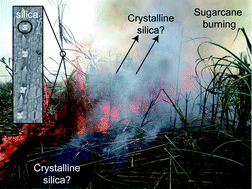Generation of crystalline silica from sugarcaneburning
Abstract

* Corresponding authors
a
Department of Geography, University of Cambridge, Downing Site, Cambridge, UK
E-mail:
jl490@cam.ac.uk
Fax: +44 (0)1223 333392
Tel: +44 (0)1223 339819
b Department of Mineralogy, Natural History Museum, Cromwell Road, London, UK
c Institute of Hazard, Risk and Resilience, Department of Earth Sciences, Durham University, Science Labs, South Road, Durham, UK
d Camborne School of Mines, College of Engineering, Mathematics and Physical Sciences, University of Exeter, Penryn, Cornwall, UK

 Please wait while we load your content...
Something went wrong. Try again?
Please wait while we load your content...
Something went wrong. Try again?
J. S. Le Blond, C. J. Horwell, B. J. Williamson and C. Oppenheimer, J. Environ. Monit., 2010, 12, 1459 DOI: 10.1039/C0EM00020E
To request permission to reproduce material from this article, please go to the Copyright Clearance Center request page.
If you are an author contributing to an RSC publication, you do not need to request permission provided correct acknowledgement is given.
If you are the author of this article, you do not need to request permission to reproduce figures and diagrams provided correct acknowledgement is given. If you want to reproduce the whole article in a third-party publication (excluding your thesis/dissertation for which permission is not required) please go to the Copyright Clearance Center request page.
Read more about how to correctly acknowledge RSC content.
 Fetching data from CrossRef.
Fetching data from CrossRef.
This may take some time to load.
Loading related content
